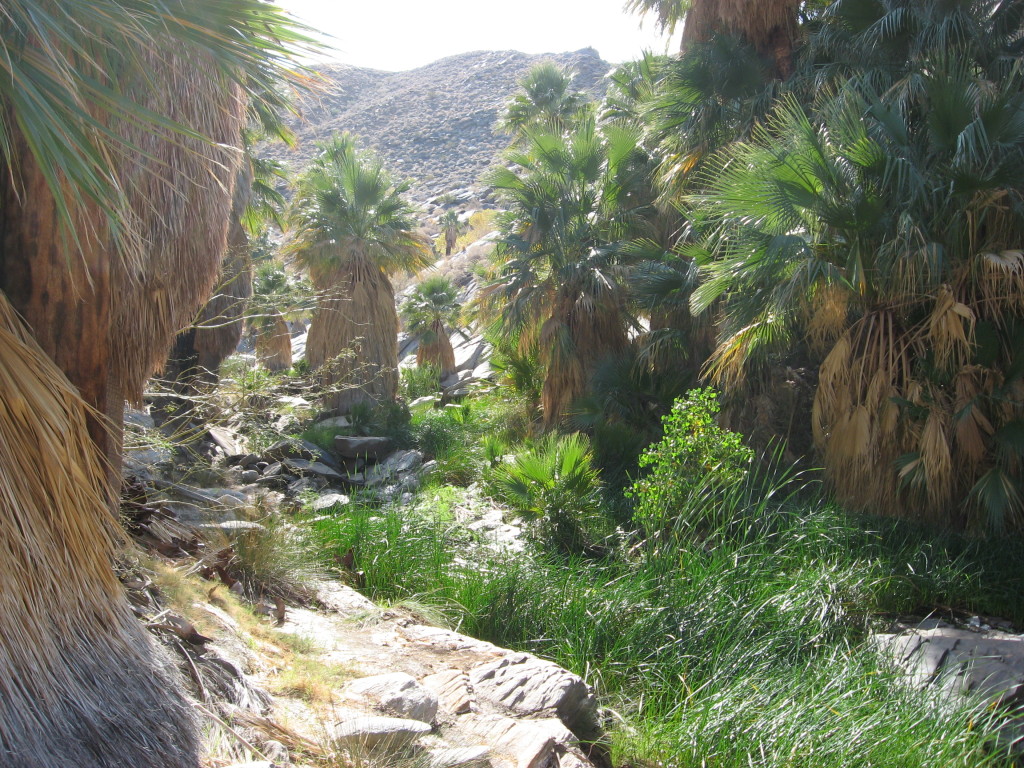On a visit to Palm Springs in early January, we hiked in the Indian Canyons. Years ago, we visited the lush canyons with our Oregon friends and were drawn back to their beauty and serenity.
Centuries ago, the trio of Palm, Andreas, and Murray canyons, with their abundant supply of water, plants and animals, were home to the Agua Caliente Band of Cahuilla Indians. Rock art, irrigation ditches and food preparation areas still exist in these canyons.
We walked, often silently, along the 15-mile Palm Canyon trail among groves of palm trees and rocky gorges surrounded by the stark Sonoran desert.
Palm Canyon has the world’s largest stand of California Fan Palm trees (Washingtonia filifera), the only palm native to the western United States. Fan-shaped fronds spread from the top of the tree and layers of dusty, dead fronds hang down against the trunk, giving it the moniker “petticoat” palm. These fronds form a protective area, providing habitat and shelter for birds, insects and small rodents.
The original California Fan Palm oases were important gathering and habitation sites and were indicative of important springs, usually located along earthquake faults. Black “berries” with a brown seed surrounded by a sweet pulp grow abundantly on the palms and provided food for native Americans.
The lands are sacred to today’s Indians and the solitude of walking along the windy, dusty trail gave us time to connect with the natural flow and beauty of Palm Canyon.


Oh that is so pretty! Sort of deserty but somehow prehistoric looking too. Beautiful! I think I may just have to go there:)
This is just lovely, and so unexpected in a desert landscape. You’ve added another place to my “must-see” list.
Beautiful.
Your beautiful photo and description brought me back to when I was 13 and visited my Grandparents in Palm Springs. Quite often we would take our picnic lunch and hike into one of these awesome canyons. I loved the feeling that those canyons had been inhabited for a long time and used well by the Indians. I especially liked those magnificent Washiontonias, my favorite palm tree. Great job, Susan.
So lovely Susan,
We enjoy seeing the pictures and the stories that go with it.
Love you
I can remember when there was moisture in the adjacent springs. Didn’t know there were any native palms here. Good to know!
I don’t know Palm Springs very well, but I do know I love the desert. When you get far enough from the road, the silence is perfect.
I think i was there once … many moons ago, but then dessert canyons do look familiar. Perfect description — enjoyed reading this short essay — as always.. thanks Susan.
Great photo and information, Susan! I am glad to see this canyon is still pristine. I believe the Native Americans have kept possession of these lands and not sold them for casinos or resorts–is that correct?
Yes the canyons are on aqua caliente reservation lands….and they are in a remote location so I think they will remain untouched for many moons! Thanks for visiting and your note Ann.
Beautiful!
Susan, the photo and the narrative are outstanding. John loved the desert (especially Death Valley) and we enjoyed hiking the many trails in various parts of So. Cal. Peggy
I have meant to go there twice in the past but never did. Now, I will make it a point to do this before any other activity in the area. Thank you for this beautiful and inspiring blog post, Susan!
Love that place! I’ve been visiting it off and on since I was a child. You’re so right. It is indeed an oasis and a place to renew one’s connection with nature. Lovely memory. Lovely write-up.
What a fascinating photo! There is a tequila in Mexico called Agua Caliente and it is one of the best! They have beautiful bottle with blowback glass fish inside. Very interesting history. Thanks, Susan, for another fabulous posting!
Very interesting, I learned a great deal.
Diana
This post really has led to some action. I am planning a trip there with Duane for later on this year. Thank you for the inspiration.
I now want to explore this area!! I love your photos